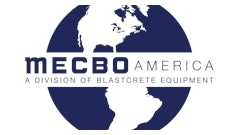
The challenge:
Remove damaged and decaying concrete in a railway tunnel while keeping the tunnel open for public transport needs
The players:
Bageci, a regional branch of industrial Belgian Group CFE
The process:
The Biereau railway tunnel just south of Brussels was in urgent need of repairs to defective concrete, and due to public transportation demands and a confined working space it was decided to use hydrodemolition to selectively remove the damaged and decaying concrete.
Since closing the tunnel completely was not an option, restoration contractor Bageci, a regional branch of industrial Belgian Group CFE, had to work on the tunnel in two sections — working and repairing concrete from one track while trains passed by slowly on the other line. The restricted space and necessary safety and environment precautions were critical considerations for the overall renovation project, which had to be completed in just 220 days.
Bageci opted to use the hydrodemolition technique, which uses a very high-pressure water jet to selectively remove the defective concrete from the walls and roof. Bageci bought a Conjet Robot 365 with multipurpose arm and a specially adapted feedbeam, carrying the cradle and jetting lance, to fit the curvature of the tunnel wall.
“Due to the special safety and environmental demands and lack of space, hydrodemolition was really our only option from the very start,” said Bageci tunnel project manager Luc Bosmans. “We thought it was going to be the most productive method for this tunnel work, and it proved to be very efficient.”
Hydrodemolition Surface Prep Keeps Pittsburgh Liberty Tunnel Rehabilitation Project on Schedule
A 500kW Hammelmann S1200-48 high-pressure water pump and the Conjet Robot were installed on flatbed rail wagons fitted with foldable, protective walls. This allowed the hydrodemolition and restoration work to be completed on one side of the tunnel while trains could safely pass on the opposite track.
In total, the Conjet Robot 365, together with the Hammelmann pump operating up to a pressure of 1,200 bar, worked 1,370 hours in the Biéreau tunnel and selectively removed approximately 2,105 cubic meters of defective concrete from the tunnel circumference at an average depth of 3 to 4 inches. The total area treated was approximately 182,986-square-feet.
Bageci also removed the concrete debris, damaged rebar and applied new high quality concrete on the tunnel lining. “This restoration has been completed in 220 days with the Conjet Robot demolishing and removing concrete at a rate of about 1.35 cubic meters (approximately 48 cubic feet) per hour. In my opinion this is an excellent result,” said Bosmans.
“Throughout the tunnel the concrete has been harder and more resistant in some places, but with the auto regulation the Conjet robot selectively demolished and removed only the damaged concrete to the right depth over the entire surface,” said Bageci site manager Sandro Bonsiambiante. “Another advantage was the high availability of the equipment. There is a lot of environmental dust and wear and tear on equipment in this kind of application and the spare parts supply has been excellent with no serious break downs.”
Originally opened in 1975, the 2,871-foot-long, 34-foot-diameter Biereau tunnel's concrete skin had begun to deteriorate and parts were falling off. Belgian railway operator Infrabel has invested more than $4 million in the tunnel's restoration.


























